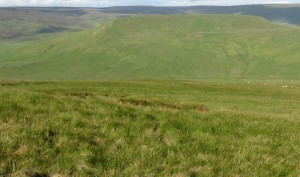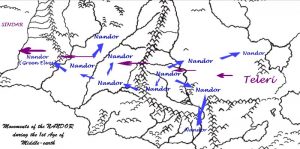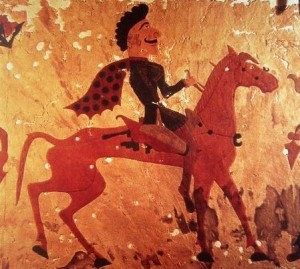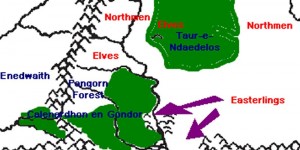

It’s cool along the banks of the Anduin, the largest river in Middle-earth. In the early morning a mist rises up and crawls across the banks, rolling into the sweeping green fields of Calenardhon. A sleep shepherd rises and begins driving his sheep toward new grazing. There is a mesmerizing silence in the damp morning air. Far off in the distance an eagle cries as it dives toward the river.
The Dunedain staked their claim in this land more than a thousand years ago, coming from the western seas in great ships with dreams of exploration. Their ancestors once strode through these fields, wandering north and east until at last they came to Beleriand, an enchanted land where empires rose and clashed.

Before the Dunedain and before their ancestors others walked in the green grass of Calenardhon: Elves, mostly Nandor but some Avari, passed quietly between the Hithaeglir to the north and the Ered Nimrais to the south. They spread northward into Enedwaith and Eriador. Eventually, some Nandor and Avari wandered into storied Beleriand as well.
Calenardhon is translated from the Sindarin as “Green Province”. It is one of the great fiefs of Gondor, defended by the fortresses at Angrenost and Aglarond. Shepherds and ranchers keep their flocks and herds in the broad green fields of the region. Calenardhon is a meat market for Gondor, a horse-preserve for royal armies. It is also a stopping point on the road north to Arnor.
The Gap of Calenardhon provides the only year-round route between East and West in the northern lands. The gentle trip from Osgiliath to Annuminas is almost leisurely. Only the remnants of the Gwathuirim and the Druedain who live in the hills and coastlands of Enedwaith dwell between Arnor and Gondor. The Elves have long since vanished, swept away by war and new political arrangements. A broad swath of Middle-earth has been handed over to Men.
On this morning, as the young shepherd tends his flock, his thoughts are not about war or Elves or dangerous enemies. Perhaps he thinks of a sweetheart waiting for him in a village near the mountains. Perhaps he thinks about where the best forage for his sheep will be in the days ahead. Perhaps he thinks about moving to one of the great cities such as Minas Anor or Osgiliath.

His idle thoughts are shattered by the cry of a horse. From the river comes the sound of many men and horses emerging from the water. They have rowed or swum across, protected by the fog, quietly massing their strength in the night.
The young shepherd looks at these newcomers in horror as he realizes that the unthinkable has happened: Gondor has been invaded. Easterlings have sprung out of legend to wreak havoc on Gondor’s quiet green province. He goes down before the swords of the eastern warriors who don’t stop to ask his name or wonder why he is there. They move on, leaving his body to be trampled or ignored by the forces that flow behind them.
Calenardhon is not without its defenses. There are soldiers of Numenorean blood and training manning the great fortresses. A few watch-posts line the river bank. Special wardens keep watch from Amon Hen, the Hill of the Eye. Other special wardens watch over the province from Angrenost, where rumor holds that the Lords of Gondor use Elvish powers to guard their realm.

The first brunt of the assault is borne by simple farmers and shepherds, herdsmen and village-folk who know nothing of war. To them, the stories of the great battles beyond the river are from a near-forgotten time five centuries in the past. The tales of Sauron’s invasion of Calenardhon during the previous age are already more than 2,000 years old.
The Numenoreans have many stories about Easterlings extending back thousands upon thousands of years. The first Easterlings were primitive barbaric clans recruited by the Noldor of Beleriand to be allies in the war against Morgoth, the first Dark Lord. Some of those Easterlings were faithful to the Elves; many were faithful to Morgoth. The faithful Easterlings paid a terrible price for befriending the Noldor and Sindar.
During the Second Age when the wars between Sauron and the Elves raged up and down the length and breadth of the Anduin, other Easterlings attached themselves to the second Dark Lord’s armies. They flowed across the river like seas of ants. Only with help from ancient Numenor was King Gil-galad and his allies able to repel Sauron’s incursions, but those victories came with great loss. And in the aftermath many Elves departed from Middle-earth, never to return.
Numenor eventually succumbed to evil and fell into darkness. Among the survivors of the ancient realm were Elendil the Tall and his followers, who came to Middle-earth in nine ships. They settled among Dunedain and other peoples and founded two great realms, Arnor and Gondor. Allying themselves with Gil-galad and the Elves, the Dunedain-in-Exile helped to overthrow Sauron once and for all.
Mordor, the grim land where the Dark Lord had established his mighty fortress was conquered and garrisoned. It remains garrisoned. All the evil creatures who once dwelt there were destroyed or driven far away. The men who served Sauron either fell into ruin or sued for peace and pardon. They pledged never to make war upon the west again.

But after 500 years their children have forgotten the old pledges, or else they have been conquered by new tribes. These new Easterlings do not march beside Orcs and Trolls. They don’t serve the Dark Lord. They simply come and claim land, seizing livestock and killing Gondor’s people.
In Calenardhon there are few refuges. Only a small number of towns or cities have the fortifications to withstand the sudden assault. The Easterlings sweep aside everything in their path. A few small forts and watch-posts are easily overcome. But the invasion falters at Angrenost and Aglarond. Reinforcements move up from Anorien. Word arrives that Ithilien, too, has been invaded. More than one tribe is involved in the invasion.
Gondor has made contact with peoples from the east before. Friendly or casual exchanges have been made with relatives of the ancestral Edain living near Greenwood and in the lands between the forest and Mordor. These clans and tribes, whom Gondorians call Northmen, bear a striking resemblance in appearance and culture to the people of Marach and Beor, the two great chieftains who led their tribes into Beleriand.
The dark-haired Beorians favor the vales of Anduin between the Hithaeglir and Greenwood. The fair-haired Marachians dwell farther east near the inland sea and farther north along the Celduin river. Some of the tribes are friendly with Elves — the rustic Silvan Elves who are descended from ancient clans of Nandor and Avari. These peoples are Easterlings in name but their blood is not the same as that of the ancient Easterlings. Nor are they the same clans who attack Gondor now.
These new Easterlings speak strange languages. There may be traces of Black Speech among their words but they use foreign names and think differently from the Dunedain and their close kin. They do not revere the Elves and have learned nothing of civilization from either the Eldar or the Silvan Elves. They come looking for new lands to settle, or perhaps glory in war and conflict.
Prince Tarostar, son of King Ondoher, leads Gondor’s victorious army in repelling the invaders and driving them eastward. After 10 years of warfare Tarostar takes the name Romendacil (“East Victor”). But his achievements are short-lived. Within a generation fresh clans of Easterlings migrate westward, renewing hostilities. The memories of the great war against Sauron have barely started fading into legend but Gondor’s long, sleepy peace has been completely overturned by a welling thunder from the east.
From this time forward, the Dunedain will face many foes and grave perils. Their power will increase and then decline. Romendacil’s victories in the east are only the first step on the road toward empire and the inevitable confrontation with a revived Sauron. But that is a tale for another day.
# # #
Have you read our other Middle-earth Unplugged articles?
